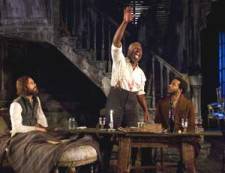Review: The Whipping Man

It’s easy to see why Matthew Lopez’s play The Whipping Man has enjoyed considerable success on the regional theater circuit. Set during the final days of the Civil War and concerning an impromptu Passover Seder conducted by a pair of black slaves and their former owner, it seems cannily designed to appeal to both African-American and Jewish audiences.
Unfortunately, the play, now receiving its New York premiere courtesy of the Manhattan Theatre Club, is less interesting than its premise. Tedious and plodding for most of its running time, it relies on a sensationalistic early scene and some melodramatic revelations towards the end for dramatic effect.
Set in a ruined antebellum mansion in Richmond, Virginia, it depicts the fateful encounter among three figures: Caleb (Jay Wilkison), the Jewish soldier who has limped back to his home with a grave injury to his leg; and Simon (Andre Bruagher) and John (Andre Holland), his family’s former slaves who have been converted to their faith.
Determining that Caleb is suffering from gangrene, Simon decides that his leg must be removed, resulting in a grisly, vividly staged amputation scene that will certainly have audiences cringing.
Not too much happens after that, with the characters engaging in windy, philosophical discussions about the horrors of the war and the issues for which it was fought. A conflict arises between Simon, who has returned to the home to safeguard the family’s possessions, and John, who has resorted to thievery and is using the house to store his booty.
The two slaves, with Caleb’s reluctant agreement, decide to hold a Seder, which provides a neatly dramatic parallel between the plight of the Jewish slaves in Egypt and their 19th century black contemporaries.
There are few dramatic fireworks until shortly before the play’s conclusion, when Simon learns shattering information about his family that propels him to action.
Atmospherically staged by Doug Hughes and featuring a gorgeously dilapidated set designed by John Lee Beatty and moodily lit by Ben Stanton, the production does feature compelling performances, especially by the ever-reliable Braugher, who brings complex shadings to his role as the conflicted ex-slave. But for all its thematic ambition, this historical drama never comes to dramatic life.
City Center Stage I, 131 W. 55th St. 212-581-1212. www.nycitycenter.org.
| Print article | This entry was posted by Frank on 02/07/11 at 05:38:58 am . Follow any responses to this post through RSS 2.0. |